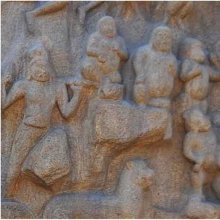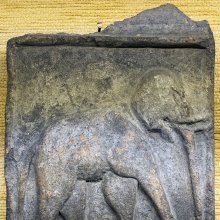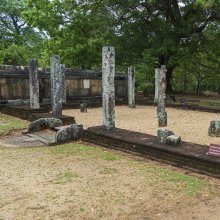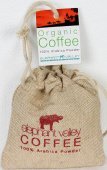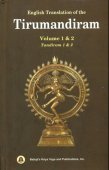Tamil, Tamiḻ: 5 definitions
Introduction:
Tamil means something in Hinduism, Sanskrit, the history of ancient India, Hindi, Tamil. If you want to know the exact meaning, history, etymology or English translation of this term then check out the descriptions on this page. Add your comment or reference to a book if you want to contribute to this summary article.
Images (photo gallery)
(+254 more images available)
In Hinduism
General definition (in Hinduism)
Source: WikiPedia: HinduismTamil is a Dravidian language spoken predominantly by Tamil people of the Indian subcontinent. It has official status in the Indian state of Tamil Nadu and in the Indian union territory of Pondicherry. Tamil is also an official language of Sri Lanka and Singapore. It is one of the 22 scheduled languages of India and the first Indian language to be declared as a classical language by the government of India in 2004. Tamil is also spoken by significant minorities in Malaysia and Mauritius as well as emigrant communities around the world.
Tamil (தமிழ், tamiḻ, [t̪ɐmɨɻ])
Tamil is one of the longest surviving classical languages in the world. It has been described as "the only language of contemporary India which is recognizably continuous with a classical past" and having "one of the richest literatures in the world". Tamil literature has existed for over 2000 years.
India history and geography
Source: Cologne Digital Sanskrit Dictionaries: Indian Epigraphical GlossaryTamil.—name of an alphabet and language. Note: tamil is defined in the “Indian epigraphical glossary” as it can be found on ancient inscriptions commonly written in Sanskrit, Prakrit or Dravidian languages.
Source: academia.edu: Minor Chiefs and "Hero" in Ancient TamilakamTamiḻ (Tamil-nāṭu/nāḍu) is a name related to the historical geography and rulers of ancient Tamil Nadu, occuring in Sangam literature such as the Akanāṉūṟu and the Puṟanāṉūṟu.—Notes: (Puṟam. 35, 198), the language and the land (Puṟam. 50, 168 VIS 324-25, Rajarajan 2017), see Damirica in the ‘Periplus’ (Sastri 2001: 57), ‘Tamiradeśa’ of the Hathigumpha Inscription (EI XX, 71-89). See Dramila in Bollée (2017: 23)

The history of India traces the identification of countries, villages, towns and other regions of India, as well as mythology, zoology, royal dynasties, rulers, tribes, local festivities and traditions and regional languages. Ancient India enjoyed religious freedom and encourages the path of Dharma, a concept common to Buddhism, Hinduism, and Jainism.
Languages of India and abroad
Hindi dictionary
Source: DDSA: A practical Hindi-English dictionary1) Tamil in Hindi refers in English to:—(nf) the oldest of the four major south Indian languages belonging to the Dravidian family; ~[nadu] the South-Indian state of Tamilnadu..—tamil (तमिल) is alternatively transliterated as Tamila.
2) Tamil in Hindi refers in English to:—(nf) carrying out, implementation (of an order); service (of summons etc.)..—tamil (तामील) is alternatively transliterated as Tāmīla.
...
Kannada-English dictionary
Source: Alar: Kannada-English corpusTamiḻ (ತಮಿೞ್):—[noun] = ತಮಿಳು [tamilu].
Kannada is a Dravidian language (as opposed to the Indo-European language family) mainly spoken in the southwestern region of India.
See also (Relevant definitions)
Starts with (+9): Tamil life, Tamil-iyalvalakku, Tamila, Tamila-pallavataraiyar, Tamilakam, Tamilakaran, Tamilakkuttu, Tamilama, Tamilan, Tamilar, Tamilataraiyan, Tamilitti, Tamilkkuccari, Tamilkkuttar, Tamilmarai, Tamilmaruntu, Tamilmuni, Tamilmunivan, Tamilnadia uliginosa, Tamilnadu.
Ends with: Alakar-pillaitamil, An-par-pillaitamil, Araputtamil, Centamil, Kannittamil, Karuntamil, Kotuntamil, Muttamil, Natakattamil, Pen-par-pillaitamil, Tintamil, Vatatamil, Vatitamil, Vellaittamil.
Full-text (+5518): Vellaittamil, Dravidabhashe, Kotuntamil, Vatitamil, Kota, Karuntamil, Tamilppatuttu, Cen-tamililakkanam, Centamil, Tamilakam, Iyarramil, Kannittamil, Tamilmaruntu, Siddha, Tamilvirakan, Tamilor, Intirakaliyam, Tintamil, Araputtamil, Tamilakaran.
Relevant text
Search found 86 books and stories containing Tamil, Tamiḻ; (plurals include: Tamils, Tamiḻs). You can also click to the full overview containing English textual excerpts. Below are direct links for the most relevant articles:
The Tamils and the Andhras < [March, 1928]
The Future of Tamil Literature < [September-October 1933]
Literary Contacts between Tamil and Telugu < [January – March, 1978]
Tiruvaymoli (Thiruvaimozhi): English translation (by S. Satyamurthi Ayyangar)
Pasuram 10.8.11 < [Section 8 - Eighth Tiruvaymoli (Tirumaliruncolai)]
Pasuram 2.7.13 < [Section 7 - Seventh Tiruvaymoli (kecavan tamar)]
Pasuram 2.8.11 < [Section 8 - Eighth Tiruvaymoli (Anaivatu Aravu-anaimel)]
Diaspora of Bhuta (Daiva) worshipping cult—India and Indonesia (by Shilpa V. Sonawane)
Chapter 2 - Survey of Research and Literature Review
Part 13 - Hypothese of Limoria in India < [Chapter 4 - Inter-Disciplinary Analysis]
Part 11 - Lumeria (Kumari Kandam) < [Chapter 4 - Inter-Disciplinary Analysis]
Temples in and around Madurantakam (by B. Mekala)
Evolution of Temples in Tamil Nadu < [Chapter 2 - Temples: Role and Influence]
Bhakti Movement < [Chapter 2 - Temples: Role and Influence]
Celebrations of various Festivals < [Chapter 5 - Pujas and Festivals]
Parama Samhita (English translation) (by Krishnaswami Aiyangar)
The Mahābhārata in the Tamil country in the Sangam age < [Introduction]
Introduction to the Parama-saṃhitā
Poems included the collection Paripāḍal expound the Pāñcarātra < [Introduction]
Dipavamsa (study) (by Sibani Barman)
Related products
(+9 more products available)

